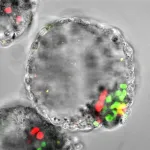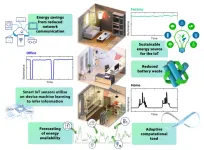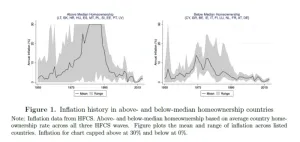(Press-News.org) A high-throughput single-cell single-mitochondrial genome sequencing technology known as iMiGseq has provided new insights into mutations of mitochondrial DNA (mtDNA) and offers a platform for assessing mtDNA editing strategies and genetic diagnosis of embryos prior to their implantation.
An international team of researchers, led by KAUST stem cell biologist Mo Li, has now quantitatively depicted the genetic maps of mtDNA in single human oocytes (immature eggs) and blastoids (stem cell-based synthetic embryos)[1]. This has revealed molecular features of rare mtDNA mutations that cause maternally inherited diseases.
Mitochondria, the “powerhouses” of cells, play a crucial role in cellular communication and metabolism. Human mtDNA is a circular genome containing 37 genes, encoding 13 proteins and a noncoding D-loop region. Heteroplasmic mutations, inherited from egg cells, can cause congenital diseases, like maternally inherited Leigh syndrome, and are associated with late-onset complex diseases.
“Next-generation sequencing has been used to sequence mtDNA and implicated heteroplasmic mutations as significant contributors to metabolic disease. Yet the understanding of mtDNA mutations remains limited due to the constraints of traditional sequencing technologies,” says lead author Chongwei Bi.
“Our new iMiGseq method is significant because it enables complete sequencing of individual mtDNA in single cells, allowing for unbiased, high-throughput base-resolution analysis of full-length mtDNA,” says Bi. iMiGseq resolves several key questions in the field.
Using third-generation nanopore sequencing technology, the researchers have characterized mtDNA heteroplasmy in single cells and described the genetic features of mtDNA in single oocytes. They have examined mtDNA in induced pluripotent stem cells derived from patients with Leigh syndrome or neuropathy, ataxia or retinitis pigmentosa (NARP). This has revealed complex patterns of pathogenic mtDNA mutations, including single nucleotide variants and large structural variants. “We were able to detect rare mutations with frequencies far below the traditional detection threshold of one percent,” says Mo Li.
In another experiment using the new technology, iMiGseq revealed the potential risks of unexpected large increases in the frequency of off-target mutations, known as heteroplasmy, in a mitochondrial genome editing method called mitoTALEN – a genome editing tool that cuts a specific sequence in mitochondrial DNA. It is used to cut a mutation that causes mitochondrial encephalomyopathy and stroke-like episodes syndrome in patient-derived induced pluripotent stem cells.
“This highlights the advantages of full-length mtDNA haplotype analysis for understanding mitochondrial DNA heteroplasmy change; other distant mtDNA genetic variants may be unintentionally affected by the editing of a genetically linked disease-relevant mutation and there is a need for ultrasensitive methods to assess the safety of editing strategies,” says Li.
The researchers also used iMiGseq to analyze single human oocytes from healthy donors and single human blastoids, synthetic embryos made from stem cells, to identify rare mutations undetectable with conventional next-generation sequencing. These low-level heteroplasmic mutations, potentially inherited through the female germline, are linked to mitochondrial diseases and cancer[2].
The iMiGseq method provides a novel means to accurately depict the complete haplotypes of individual mtDNA in single cells, offering an ideal platform for explaining the cause of mitochondrial mutation-related diseases, evaluating the safety of various mtDNA editing strategies and unraveling the links between mtDNA mutations, ageing and the development of complex diseases.
END
Uncovering hidden mitochondrial mutations in single cells
2023-04-13
ELSE PRESS RELEASES FROM THIS DATE:
Effectiveness of COVID-19 mRNA vaccination for children and adolescents confirmed by multi-state study
2023-04-13
A multi-state study from the Centers for Disease Control and Prevention’s (CDC’s) VISION Network confirms that the Pfizer-BioNTech mRNA COVID-19 vaccine has provided children and adolescents, ages 5-17, with protection against both moderate and severe COVID-19 outcomes.
The study found that for 12-17 year olds, vaccine effectiveness was high against the Delta variant but lower during Omicron dominance, including BA.4 and BA.5. Due to the youngest age (5-11) group’s ineligibility for vaccination during Delta predominance, vaccine effectiveness could be estimated for these children only during the Omicron predominant ...
Four early-career cancer researchers earn prestigious annual award from NCCN Foundation
2023-04-13
PLYMOUTH MEETING, PA [April 13, 2023] — The National Comprehensive Cancer Network® (NCCN®) and the NCCN Foundation® today announced four winners for the 2023 NCCN Foundation Young Investigator Awards. These annual awards honor up-and-coming leaders in oncology research working to investigate and advance cancer care. The honorees will each receive up to $150,000 in funding for projects that will run over two years. The selection process is overseen by the NCCN Oncology Research Program (ORP) which will also provide oversight.
“It is a privilege to support these emerging innovators ...
Some people may be attracted to others over minimal similarities
2023-04-13
We are often attracted to others with whom we share an interest, but that attraction may be based on an erroneous belief that such shared interests reflect a deeper and more fundamental similarity—we share an essence—according to research published by the American Psychological Association.
“Our attraction to people who share our attributes is aided by the belief that those shared attributes are driven by something deep within us: one’s essence,” said lead author Charles Chu, PhD, an assistant professor at the Boston University Questrom School of Business. “To put it concretely, we like someone who agrees with us on a political issue, shares our music ...
The Biophysical Journal launches Postdoctoral Reviewer Program
2023-04-13
Today the Biophysical Journal is launching a new initiative, the Postdoctoral Reviewer Program. The program provides postdoctoral researchers in biophysics the opportunity to partner with Associate Editors and complete reviews that will be used in deciding whether articles will be accepted for publication.
Candidates for this program must be in a postdoctoral position during the 2023–2024 academic year and a member of BPS in good standing. Applications for the new program will be accepted through July 1 for a single-year term beginning in September 2023. Interested candidates can find more information about the program and application process online.
“I am extremely ...
Scientists create high-efficiency sustainable solar cells for IoT devices with AI-powered energy management
2023-04-13
Newcastle University researchers have created environmentally-friendly, high-efficiency photovoltaic cells that harness ambient light to power internet of Things (IoT) devices.
Led by Dr Marina Freitag, the research group from the from School of Natural and Environmental Sciences (SNES) created dye-sensitized photovoltaic cells based on a copper(II/I) electrolyte, achieving an unprecedented power conversion efficiency of 38% and 1.0V open-circuit voltage at 1,000 lux (fluorescent lamp). The cells are non-toxic and environmentally friendly, setting a new standard for sustainable ...
A sharper look at the M87 black hole
2023-04-13
The iconic image of the supermassive black hole at the center of M87—sometimes referred to as the “fuzzy, orange donut”—has gotten its first official makeover with the help of machine learning. The new image further exposes a central region that is larger and darker, surrounded by the bright accreting gas shaped like a “skinny donut.” The team used the data obtained by the Event Horizon Telescope (EHT) collaboration in 2017 and achieved, for the first time, the full resolution of the array.
In 2017, the EHT collaboration used a network of seven pre-existing telescopes ...
Gentle method allows for eco-friendly recycling of solar cells
2023-04-13
By using a new method, precious metals can be efficiently recovered from thin-film solar cells. This is shown by new research from Chalmers University of Technology, Sweden. The method is also more environmentally friendly than previous methods of recycling and paves the way for more flexible and highly efficient solar cells.
Today there are two mainstream types of solar cells. The most common is silicon-based and accounts for 90 percent of the market. The other type is called thin-film solar cells which in turn uses three main sub-technologies, one of which is known as CIGS ...
Infant formulas promise too much
2023-04-13
Many infant formulas promise a lot. Several products claim that they help develop the brain, increase immunity and promote children's growth and development, among other things.
Now a research group led by Imperial College London has looked at whether these promises have any substance to them. The article has recently been published in BMJ.
“Most of the claims about the health-giving and nutritional properties of breast milk substitutes seem to be based on little or no evidence,” the research group says.
Claims surrounding these replacement milk products are controversial. They can give the impression ...
CESJ selected for the ERC grant to launch a European program of science journalists in residence
2023-04-13
Milan (Italy), 13 April 2023 – The Center for Ethics in Science and Science Journalism (CESJ, www.cesj.eu) is among the partners of the FRONTIERS consortium that was selected by the European Research Council for a grant of 1.5 million euro to establish a residency program for science journalists in research institutions across Europe, and measure its impact on the lifelong professional development of science journalism in Europe. The consortium also includes the NOVA University of Lisbon (Portugal), ...
Living through high inflation increases home ownership
2023-04-13
People who experience periods of high inflation are more likely to buy a home, according to a new study from the University of California San Diego’s Rady School of Management.
The paper, to be published in The Journal of Finance, uses various sources of data which reveal households that have been exposed to high inflation are more likely to invest in real estate. The study suggests many homeowners buy because they are motivated to protect themselves from possible future price hikes.
The study is the first to reveal that personal ...







